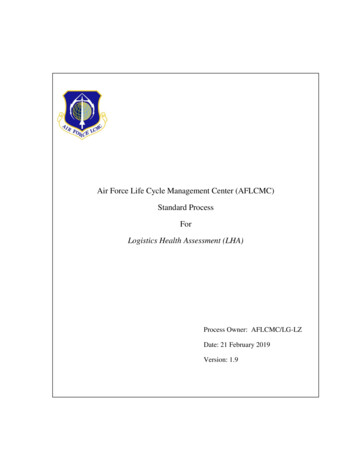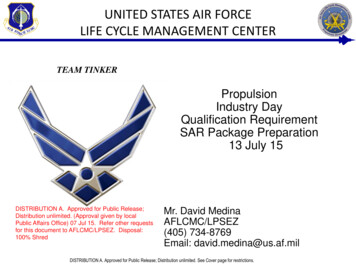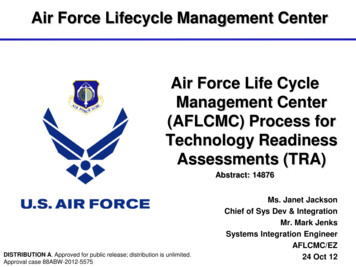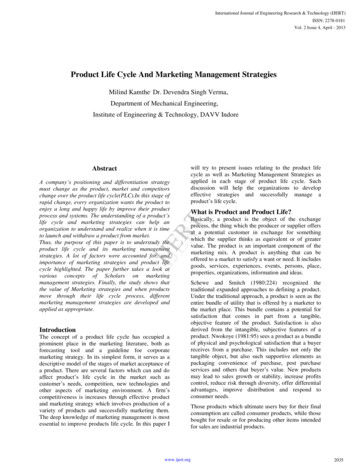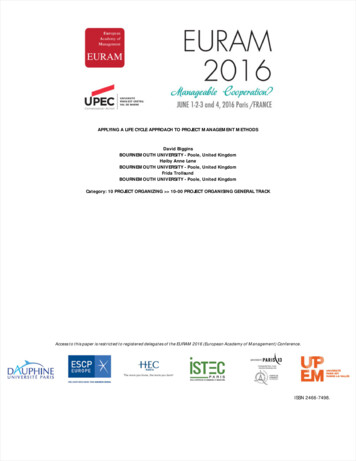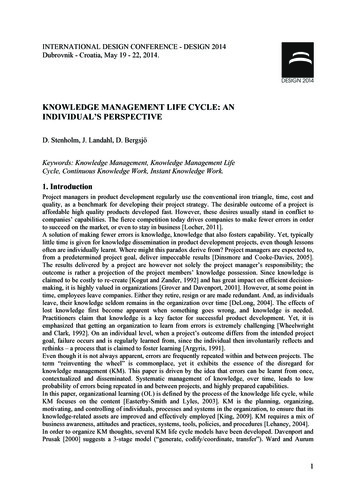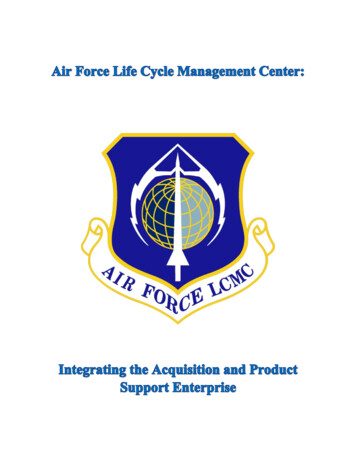
Transcription
Air Force Life Cycle Management Center:Integrating the Acquisition andProduct Support EnterpriseAir Force Life Cycle Management Center History OfficeWright-Patterson Air Force Base, Ohio2017
TABLE OF CONTENTSThe Wright Brothers Lead the Way .1McCook Field: A Foundation Is Established .2A New Home: Wright Field.4World War II Reorganization and Expansion.5A New Air Force Brings Specialized Commands and Product Centers .7Post-Cold War Reform and Consolidation .8A Five-Center Construct .10A Center for Life Cycle Management .11Air Force Life Cycle Management Center Activates .11Conclusion .18APPENDICESA. AFLCMC Lineage and Honors .20B. AFLCMC Commanders .21C. AFLCMC Emblem and Heraldic Device .22D. AFLCMC Assigned Personnel.24E. AFLCMC Units 2012-2016.25F. AFLCMC Unit Locations 2016 .29iii
AIR FORCE LIFE CYCLE MANAGEMENT CENTER:Integrating the Acquisition and Product Support EnterpriseThe Wright Brothers Lead the WayThe legacy of the Air Force Life Cycle Management Center (AFLCMC) began with thepioneering work of Orville and Wilbur Wright from 1899 to 1903 that enabled them toachieve the first manned, powered flight. After their success at Kitty Hawk, they returnedhome to Dayton, Ohio, where in 1904 and 1905 they perfected their flying skills while turningthe Wright Flyer into the first practical airplane capable of fully-controlled flight. Theyaccomplished this work at a site known as the Huffman Prairie Flying Field, now a part ofWright-Patterson Air Force Base where AFLCMC is headquartered.Wright Brothers on Huffman Prairie 1904In 1907, the Aeronautical Division was established within the Office of the Chief SignalOfficer of the Army and put in charge “of all matters pertaining to military ballooning, airmachines, and all kindred subjects on hand.” The Signal Corps fleet consisted of two balloonsand one dirigible. Following Orville Wright’s successful test flight of an aircraft at Fort Meyer,Virginia, the Army Signal Corps took delivery on August 2, 1909 of Signal Corps AirplaneNo. 1 at a total cost of 30,000. (Signal Corps Specification, No. 486). Through their research,development, production, and logistics, the Wrights pioneered the aerospace system life cyclemanagement process, which the Signal Corps acquired along with Airplane No. 1.1
Fort Meyer Flight Test of Signal Corps Aircraft No. 1McCook Field: A Foundation Is EstablishedThe advent of World War I found the United States technologically ill-prepared to assistthe allies in fighting an air war. In July 1914 the Army Signal Corps Aviation Section,the successor to the Aeronautical Division, had 30 aircraft and 40 pilots. When theUnited States entered the war in April 1917, those numbers had risen to about 200 airplanes, butnone were fit for combat, and fewer than 1,200 men were assigned to the Aviation Section. Bythe November 11, 1918 Armistice, the 45 American Expeditionary Force squadrons had 740airplanes equipped with the latest armament, 12 of them flying American built planes.Engineering Division, McCook Field2
McCook FieldTo meet wartime demands, the Signal Corps sought a new location for construction of atemporary experimental engineering field where all Army aircraft engineering and procurementfunctions could be consolidated. A site north of downtown Dayton, Ohio, was selected andconstruction of McCook Field began in October 1917. The field soon became home to theSignal Corps (later Air Service) Airplane Engineering Department.Over the next decade, the Airplane Engineering Department (renamed the AirplaneEngineering Division) served as the center of all Army aviation research and development.McCook Field’s engineers kept the skies humming with flight tests. They also designedMcCooksuchFieldasStaffprotective clothing and other improvementsclosed cockpits, heated and pressurizedcabins, oxygen systems, the concept of the electric ignition system, as well as the invention ofanti-knock fuels. They worked on improving navigational aids, weather forecasting techniques,propellers, aerial photography, and the design of landing and wing lights for night flying. In3
short, they were engaged in the research, development, and acquisition of everything related toflying.In 1925, the Engineering Division’s role shifted from aircraft design and construction toacquiring and evaluating prototype systems submitted by commercial aircraft companies. Thetransition to commercial suppliers forced manufacturers to compete with each other to producequality aircraft. This change freed McCook’s engineers to concentrate on developing standardsunique to military aircraft, reviewing designs, modifying and testing procured machines, anddeveloping ancillary equipment to enhance military aircraft.A New Home: Wright FieldIn 1926, the Engineering Division and the Field Service Section were combined under thenewly established Army Air Corps to form the Materiel Division, which was givenresponsibility for aeronautical research, procurement, supply, and maintenance. Theexpanding Materiel Division required betterquarters than the temporary facilities andlimited runway available at McCook Fieldand the search for a new location began.With Dayton facing the threatened loss ofMcCook Field’s operations, John H.Patterson, President of the National CashRegister Corporation in Dayton, initiated alocal campaign to raise money to purchasea tract of land large enough for a new airfield. A coalition of prominent Daytoncitizens and businessmen conducted acampaign that raised 425,000 in two days,enough to purchase 4,520 acres east of Dayton, including Wilbur Wright Field (a flying fieldalready leased by the Air Service which included the Huffman Prairie). In August 1924, the AirService accepted Dayton’s gift and agreed to build a new field on the site.Wright Field was officially dedicated on October12, 1927 and the McCook Field laboratories andengineering shops were moved to the new home of theMateriel Division. Wright Field’s facilities included amain laboratory, a final assembly hangar and adjacentshops, a dynamometer laboratory, wind tunnels, propellertest facilities, an airship hangar, an armament range, afoundry, and other supporting facilities.The Wright Field staff began acquiring aircraftdesigned to fulfill specific mission roles. The firstproduction attack, cargo, and bomber aircraft were soonbeing delivered. Meanwhile, Wright Field’s engineersand scientists developed navigation and communications4
equipment, cockpit instrumentation, electrically-heated flight clothing, and in-flight refuelingequipment. However, Congress’ continued severe underfunding of the Army Air Corps up to theeve of World War II left the service a small, poorly-equipped, and outdated force compared tothe adversaries it would soon engage.Wright Field, 1927World War II Reorganization and ExpansionUnder the Lend-Lease Act of 1941, the Materiel Division began supplying armament,aircraft, and equipment to the European Allies. These operations expanded massivelywhen the United States entered World War II in December 1941. The previous June, theArmy Air Corps had been redesignated the Army Air Forces. In October the engineering andlogistics functions, which had been combined in 1926 as the Materiel Division, were separatedagain and the logistics activities moved to the new Air Service Command. The MaterielDivision became Materiel Command in 1942 and was given responsibility for planning,development, testing, evaluation, modification, contracting, and coordinating production for allArmy aircraft deployed worldwide. Subsequent jurisdictional conflicts between Materiel and AirService Commands resulted in the August 31, 1944 establishment of Air Technical ServiceCommand (renamed Air Materiel Command in 1946) which once again reunited the research,development, acquisition, and logistics functions.5
Building 262, Wright-Patterson Air Force Base, was Headquarters for Air ServiceCommand, Air Materiel Command, Air Force Logistics Command, and Air ForceMateriel Command.Hanscom Field6
The massive scope of defense work during World War II resulted in many Wright Fieldfunctions moving to new locations. Wartime work conducted by the Massachusetts Institute ofTechnology at Hanscom Field paved the way for Hanscom to emerge as the post-war center forthe development and acquisition of electronic systems. Eglin Field, Florida, was established as aproving ground for aircraft armament. Kirtland Army Air Field in New Mexico transitionedfrom a flight training center in 1946 to a flight test center. It also assumed responsibility fordeveloping aircraft modifications for weapons delivery, determining ballistic characteristics forweapons of the future, and testing and evaluating special weapons. Tinker Field in Oklahomarepaired and modified bombers and cargo planes. It also overhauled thousands of aircraftengines enroute to becoming the Air Force’s premier propulsion facility. The immense volumeof flight test work and the need for a secret location to test experimental aircraft drove flighttesting from Wright Field to Rogers Dry Lake in Muroc, California, which later become the AirForce Flight Test Center, Edwards Air Force Base.A New Air Force Brings Specialized Commands and Product CentersThe Air Force became an independent service in 1947. Growing involvement withresearch and development activities and the advent of more technologically sophisticatedsystems gave impetus to the new service’s reassessment of the roles of research,acquisition, and logistics. In 1950 the Air Force announced the creation of a separate commandfor research and development. Those missions transferred from Air Materiel Command to thenew Air Research and Development Command(ARDC). In 1951 ARDC placed the principalelements of engineering, the laboratories, and flighttesting under the Wright Air Development Center(WADC) at Wright-Patterson Air Force Base. Thefollowing year, ARDC brought together armamentdevelopment and testing in what would become theAir Force Armament Center at Eglin AFB, Florida.During the 1950’s, aeronautical developmentin the Air Force was the WADC mission. WADC’sseven divisions (Weapons Systems, WeaponsComponents, Research, Aeronautics, All-WeatherFlying, Flight Test, and Materiel) and 12 laboratoriesconducted research and development efforts throughWeapon System Project Offices (WSPOs). The WSPO concept originated from Germany’sWorld War II missile development program, where missile designers were forced to focus on theentire system rather than simply build an airframe, then hang engines, avionics, and armament onit. This original concept evolved into the modern Air Force System Program Office (SPO).In 1961, the Air Force announced a substantial reorganization of the systems acquisitionstructure. The research and development mission of the Air Research and DevelopmentCommand was combined with the procurement and production mission of Air MaterielCommand to form Air Force Systems Command (AFSC). The mission of AFSC and itssubordinate units was to manage the research, development, and acquisition of aerospace7
systems. The Aeronautical Systems Division (ASD) activated at Wright-Patterson Air ForceBase April 1, 1961 replaced WADC and assumed its missions. Simultaneously, the ElectronicSystems Division (ESD) activated at Hanscom AFB and was tasked to consolidate managementof the Air Force’s electronic systems under one agency.Post-Cold War Reform and ConsolidationThe end of the Cold War combined with a declining Soviet threat, federal budgetconstraints, and the high cost of modern technology triggered Air Force reassessments ofits acquisition processes as well as research, development, and logistics roles. Congressalso began passing substantial legislation designed to improve and increase oversight ofacquisition programs. These actions generated a host of management tools and initiatives suchas total quality management, activity based costing, lean aerospace initiative, integrated weaponsystems management, and strategic planning to foster production of more reliable systems thatcould be delivered faster and cheaper. Other reforms focused on integrating all functional lifecycle requirements into the development of weapon systems.A 1986 Blue Ribbon Commission on Defense Management (Packard Commission) andthe Goldwater-Nichols DoD Reorganization Act laid the groundwork for the coming reforms.A follow-on Defense Management Report directed by President George H.W. Bush outlined apath to improve weapons procurement and Pentagon management by fully implementing thePackard Commission recommendations. Accordingly, in 1990 management authority for majorprograms was transferred from AFSC to independent Program Executive Officers (PEOs) at thePentagon. PEOs were established for six mission areas: space systems, strategic systems, tacticalstrike systems, tactical airlift systems, information support systems, and command, control, andcommunications systems. Product center system program managers reported directly to theirPEOs at the Pentagon, bypassing both the system divisions and the AFSC commander. AFSC,however, retained program management authority for minor programs.8
On January 10, 1991, the Secretary of the AirForce announced that Air Force Systems Command andAir Force Logistics Command would inactivate and AirForce Materiel Command (AFMC) would be establishedand activated at Wright-Patterson AFB, Ohio, on July 1,1992. This announcement started the first completeoverhaul of Air Force materiel management since 1961.AFMC did more than reunify the research, development,procurement, and sustainment missions within a singlemajor command. It developed a new culture by drawingupon the talents, capabilities, and best practices of bothAFSC and AFLC while incorporating modernmanagement concepts, tools, and processes. AFMCbecame responsible for the full spectrum of activitiesnecessary to provide systems to the warfighter and to support them from “cradle to grave.” TheAeronautical Systems Division and Electronic Systems Division were redesignated as Centers.The 88th Air Base Wing, the host organization for Wright-Patterson Air Force Base, wasassigned to the Aeronautical Systems Center. In 1994 ASC’s 4950th Test Wing inactivated andits operations moved to the Air Force Flight Test Center.Further restructuring came in 1997 when the Air ForceResearch Laboratory (AFRL) was activated. AFRLseparated the research units from the product centers andconsolidated the Air Force’s laboratories to reducemanpower and more easily serve the entire Air Forcerather than just their assigned product centers. The nextyear, the Air Force Development Test Center at EglinAFB, Florida, became the Air Armament Center, aproduct center responsible for development, acquisition,testing, and fielding of all air-delivered weapons. TheHuman Systems Center at Brooks AFB, Texas, was alsoreintegrated into the Aeronautical Systems Center.In 2003, the Air Force Chief of Staff initiated a review of the Air Force’s product,logistics, and test centers to make them more recognizable and understandable to theircounterparts across the Air Force. The review drove an Air Force decision to improve programaccountability by consolidating its PEO portfolios around larger mission groups and relocatingthem to the product centers. A second decision in 2005 replaced the System Program Offices atthe product centers with standard Air Force units—wings, groups, and squadrons. These unitswere assigned their own organic functional resources and manpower. Matrix management, thepractice of detailing functional support as needed to the program offices, was eliminated. AirForce leaders believed military units would make acquisition and product centers moretransparent to the operational side of the service, reduce confusion when programs moved fromthe acquisition to the sustainment phase, and establish better program accountability.9
The military units soon faced new problems. Their structure prevented senior managersfrom quickly detailing specialists and moving personnel between program offices and units asneeded. Administrative tasks and a hierarchical structure burdened commanders and slowed theflow of information and decision making. Consequently, the military unit structure was replacedin 2010 with named directorates, divisions, and branches. Smaller PEO portfolios wereco-located with their product centers rather than in Washington, D.C. The PEOs, whilecontinuing to report to the Service Acquisition Executive at the Pentagon, were also nameddirectors of their respective product center directorates.A Five-Center ConstructOn June 4, 2010, the Secretary of Defense issued a memorandum challenging the militaryservices to eliminate redundant functions and increase funding for mission functionsthrough efficiency savings in overhead, support, and non-core mission areas.A subsequent Air Force strategic review revealed imbalances between high priority areasthat required more manpower and management overhead functions that needed to bestreamlined. A DoD Resource Management Decision freezing civilian manpower at FY 2010budget levels forced the Air Force to initiate a variety of measures to correct manpowerimbalances and realign scarce resources to the most critical missions. AFMC’s senior leadersdecided in 2011 to attack the issue by restructuring the command’s centers from twelve locationspecific subordinate organizations requiring full support staffs into five mission-based, integratedlife cycle centers.10
The five-center construct was designed to reduce overhead costs and redundant layers ofstaff. Its benefits included fostering a life cycle management focus, integrating maintenance andsupply chain functions, and improving the goal of presenting a single face to customers. Theconsolidated organizations would standardize business practices, streamline processes anddecision making authority, and bring AFMC into a one mission-one commander alignment.AFMC’s five centers would be the Air Force Life Cycle Management Center (AFLCMC) atWright-Patterson AFB, Ohio; the Air Force Sustainment Center (AFSC) at Tinker Air ForceBase, Oklahoma; the Air Force Test Center (AFTC) at Edwards AFB, California; the Air ForceResearch Laboratory (AFRL) at Wright-Patterson Air Force Base; and the Air Force NuclearWeapons Center (AFNWC) at Kirtland AFB, New Mexico. The restructuring would eliminateover 1,000 civilian positions while preserving mission capability. The result would also unleashthe full power of the system program manager
Wright-Patterson Air Force Base where AFLCMC is headquartered. Wright Brothers on Huffman Prairie 1904 . In 1907, the Aeronautical Division was established within the Office of the Chief Signal Officer of the Army and put in charge “of all matters pertaining to military ballooning, air
